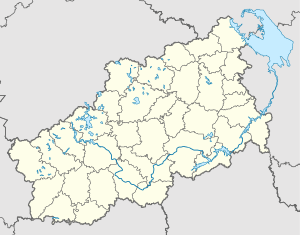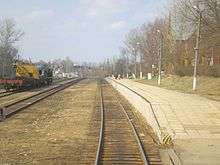Kuvshinovo, Kuvshinovsky District, Tver Oblast
| Kuvshinovo (English) Кувшиново (Russian) | |
|---|---|
| - Town[1] - | |
|
Central square in Kuvshinovo | |
.svg.png) Location of Tver Oblast in Russia | |
 Kuvshinovo | |
|
| |
.png) | |
|
| |
| Administrative status (as of December 2012) | |
| Country | Russia |
| Federal subject | Tver Oblast[1] |
| Administrative district | Kuvshinovsky District[2] |
| Urban settlement | Kuvshinovo[2] |
| Administrative center of | Kuvshinovsky District,[3] Kuvshinovo Urban Settlement[2] |
| Municipal status (as of June 2006) | |
| Municipal district | Kuvshinovsky Municipal District[4] |
| Urban settlement | Kuvshinovo Urban Settlement[4] |
| Administrative center of | Kuvshinovsky Municipal District,[5] Kuvshinovo Urban Settlement[4] |
| Statistics | |
| Population (2010 Census) | 10,007 inhabitants[6] |
| Time zone | MSK (UTC+03:00)[7] |
| Postal code(s)[8] | 172110–172112 |
| Kuvshinovo on Wikimedia Commons | |
Kuvshinovo (Russian: Кувши́ново) is a town and the administrative center of Kuvshinovsky District in Tver Oblast, Russia, located on the Osuga, 133 kilometers (83 mi) from Tver, the administrative center of the oblast. Population: 10,007 (2010 Census);[6] 11,276 (2002 Census);[9] 12,435 (1989 Census).[10]
History
The selo of Kamenka, the predecessor of Kuvshinovo, was first mentioned in 1646.[11] In the course of the administrative reform carried out in 1708 by Peter the Great, it was included into Ingermanlandia Governorate (since 1710 known as Saint Petersburg Governorate), and in 1727 Novgorod Governorate split off. In 1775, Tver Viceroyalty was formed from the lands which previously belonged to Moscow and Novgorod Governorates, and the area was transferred to Tver Viceroyalty, which in 1796 was transformed to Tver Governorate. Kamenka belonged to Novotorzhsky Uyezd (with the center in Torzhok).
In the 18th century, a paper mill was opened close to Kamenka. In 1869, merchant Mikhail Kuvshinov bought the mill and considerably expanded it. The mill became known as the Kuvshinov Paper Mill. In 1912, a railway from Torzhok was completed, and the new station next to Kamenka was opened. The station was named Kuvshinovo, after the mill. Eventually, a settlement around the station developed, also with the name Kuvshinovo.[11]
On 1 October 1929, governorates and uyezds were abolished, and Kamensky District with the administrative center in Kuvshinovo was established. It belonged to Rzhev Okrug of Western Oblast.[12][13] On August 1, 1930 the okrugs were abolished, and the districts were subordinated directly to the oblast. On January 29, 1935 Kalinin Oblast was established, and Kamensky District was transferred to Kalinin Oblast.[12][14] In 1938, the selo of Kamenka and the settlement of Kuvshinovo were merged into the town of Kuvshinovo.[13] In February 1963, during the abortive administrative reform by Nikita Khrushchev, Novotorzhsky, Likhoslavlsky, and Kamensky Districts were merged into a new district which was called Torzhoksky District. On January 12, 1965 Kuvshinovsky District (which occupied the same area as the former Kamensky District) was re-established.[14] In 1990, Kalinin Oblast was renamed Tver Oblast.[13]
Administrative and municipal status
Within the framework of administrative divisions, Kuvshinovo serves as the administrative center of Kuvshinovsky District.[3] As an administrative division, it is incorporated within Kuvshinovsky District as Kuvshinovo Urban Settlement.[2] As a municipal division, this administrative unit also has urban settlement status and is a part of Kuvshinovsky Municipal District.[4]
Economy
Industry
The main industry branch in Kuvshinovo is paper production.[15] The Kuvshinovo Paper Mill (built in the 19th century by merchant Kuvshinov, hence the name) was producing paper until the 1990s, and then the local timber production stopped, and the mill had to switch to cardboard production.[16]
Transportation

A railway line which connects Likhoslavl with Soblago via Torzhok and Selizharovo passes Kuvshinovo. It is served by infrequent passenger traffic.
A road connecting Torshok with Ostashkov runs through Kuvshinovo. Another road connects Kuvshinovo with Vyshny Volochyok via Yesenovichi. There are local roads as well, with the bus traffic originating from Kuvshinovo.
Culture and recreation
Kuvshinovo has three objects classified as cultural and historical heritage of local significance. All of them are the remains of the former Kuvshinov Estate.[17] The town has a local museum as well.[16]
References
Notes
- 1 2 Law #34-ZO
- 1 2 3 4 Law #34-ZO stipulates that the borders of the settlements (administrative-territorial divisions) are identical to the borders of the urban and rural settlements (municipal divisions), and that the borders of the administrative districts are identical to the borders of the municipal districts. Law #33-ZO, which describes the borders and the composition of the municipal formations in Kuvshinovsky Municipal District, lists the town of Kuvshinovo as a part and the administrative center of Kuvshinovo Urban Settlement of that district.
- 1 2 Государственный комитет Российской Федерации по статистике. Комитет Российской Федерации по стандартизации, метрологии и сертификации. №ОК 019-95 1 января 1997 г. «Общероссийский классификатор объектов административно-территориального деления. Код 28 234», в ред. изменения №259/2014 от 12 декабря 2014 г.. (State Statistics Committee of the Russian Federation. Committee of the Russian Federation on Standardization, Metrology, and Certification. #OK 019-95 January 1, 1997 Russian Classification of Objects of Administrative Division . Code 28 234, as amended by the Amendment #259/2014 of December 12, 2014. ).
- 1 2 3 4 Law #33-ZO
- ↑ Law #4-ZO
- 1 2 Russian Federal State Statistics Service (2011). "Всероссийская перепись населения 2010 года. Том 1" [2010 All-Russian Population Census, vol. 1]. Всероссийская перепись населения 2010 года (2010 All-Russia Population Census) (in Russian). Federal State Statistics Service. Retrieved June 29, 2012.
- ↑ Правительство Российской Федерации. Федеральный закон №107-ФЗ от 3 июня 2011 г. «Об исчислении времени», в ред. Федерального закона №271-ФЗ от 03 июля 2016 г. «О внесении изменений в Федеральный закон "Об исчислении времени"». Вступил в силу по истечении шестидесяти дней после дня официального опубликования (6 августа 2011 г.). Опубликован: "Российская газета", №120, 6 июня 2011 г. (Government of the Russian Federation. Federal Law #107-FZ of June 31, 2011 On Calculating Time, as amended by the Federal Law #271-FZ of July 03, 2016 On Amending Federal Law "On Calculating Time". Effective as of after sixty days following the day of the official publication.).
- ↑ Почта России. Информационно-вычислительный центр ОАСУ РПО. (Russian Post). Поиск объектов почтовой связи (Postal Objects Search) (Russian)
- ↑ Russian Federal State Statistics Service (May 21, 2004). "Численность населения России, субъектов Российской Федерации в составе федеральных округов, районов, городских поселений, сельских населённых пунктов – районных центров и сельских населённых пунктов с населением 3 тысячи и более человек" [Population of Russia, Its Federal Districts, Federal Subjects, Districts, Urban Localities, Rural Localities—Administrative Centers, and Rural Localities with Population of Over 3,000] (XLS). Всероссийская перепись населения 2002 года [All-Russia Population Census of 2002] (in Russian). Retrieved August 9, 2014.
- ↑ Demoscope Weekly (1989). "Всесоюзная перепись населения 1989 г. Численность наличного населения союзных и автономных республик, автономных областей и округов, краёв, областей, районов, городских поселений и сёл-райцентров" [All Union Population Census of 1989: Present Population of Union and Autonomous Republics, Autonomous Oblasts and Okrugs, Krais, Oblasts, Districts, Urban Settlements, and Villages Serving as District Administrative Centers]. Всесоюзная перепись населения 1989 года [All-Union Population Census of 1989] (in Russian). Институт демографии Национального исследовательского университета: Высшая школа экономики [Institute of Demography at the National Research University: Higher School of Economics]. Retrieved August 9, 2014.
- 1 2 Кувшиново (in Russian). Kuvshinovo Town Portal. Retrieved 17 December 2014.
- 1 2 Воробьёв, М. В. (1993). Г. В. Туфанова, ed. Административно-территориальное деление Смоленской области (in Russian). Государственный архив Смоленской области. pp. 118–133.
- 1 2 3 Малыгин, П. Д.; Смирнов, С. Н. (2007). История административно-территориального деления Тверской Области (PDF). Tver. pp. 14–15. OCLC 540329541.
- 1 2 Справка об изменениях в административно-территориальном делении Тверской губернии - Калининской области (in Russian). Архивы России. Retrieved 1 March 2014.
- ↑ Паспорт Кувшиновского района Тверской области в сфере АПК (PDF) (in Russian). ГКУ ТО «Центр развития АПК Тверской области». Retrieved 3 December 2014.
- 1 2 Размахнин, Антон (April 4, 2012). Кувшиново: 3 составляющих (не)успеха. Pravoslaviye i Mir (in Russian). Retrieved 7 December 2014.
- ↑ Памятники истории и культуры народов Российской Федерации (in Russian). Russian Ministry of Culture. Retrieved 2 June 2016.
Sources
- Законодательное Собрание Тверской области. Закон №34-ЗО от 17 апреля 2006 г. «Об административно-территориальном устройстве Тверской области», в ред. Закона №66-ЗО от 1 октября 2014 г. «О внесении изменения в статью 18 Закона Тверской области "Об административно-территориальном устройстве Тверской области"». Вступил в силу со дня официального опубликования. Опубликован: "Тверские ведомости", №17 (специальный выпуск), 19 апреля 2006 г. (Legislative Assembly of Tver Oblast. Law #34-ZO of April 17, 2006 On the Administrative-Territorial Structure of Tver Oblast, as amended by the Law #66-ZO of October 1, 2014 On Amending Article 18 of the Law of Tver Oblast "On the Administrative-Territorial Structure of Tver Oblast". Effective as of the official publication date.).
- Законодательное Собрание Тверской области. Закон №33-ЗО от 28 февраля 2005 г. «Об установлении границ муниципальных образований, входящих в состав территории муниципального образования Тверской области "Кувшиновский район", и наделении их статусом городского, сельского поселения», в ред. Закона №52-ЗО от 6 июня 2006 г. «О внесении изменений в отдельные Законы Тверской области, регулирующие вопросы установления границ муниципальных образований Тверской области». Вступил в силу со дня официального опубликования. Опубликован: "Тверские ведомости", №10, 11–17 марта 2005 г. (Legislative Assembly of Tver Oblast. Law #33-ZO of February 28, 2005 On Establishing the Borders of the Municipal Formations Comprised by the Territory of the Municipal Formation of "Kuvshinovsky District" and on Granting Them the Status of Urban, Rural Settlements, as amended by the Law #52-ZO of June 6, 2006 On Amending Various Laws of Tver Oblast on Regulating the Issues of Establishing the Borders of the Municipal Formations of Tver Oblast. Effective as of the day of the official publication.).
- Законодательное Собрание Тверской области. Закон №4-ЗО от 18 января 2005 г. «Об установлении границ муниципальных образований Тверской области и наделении их статусом городских округов, муниципальных районов», в ред. Закона №65-ЗО от 24 июля 2012 г. «О внесении изменения в статью 2 Закона Тверской области "Об установлении границ муниципальных образований Тверской области и наделении их статусом городских округов, муниципальных районов"». Вступил в силу через десять дней после официального опубликования. Опубликован: "Тверские ведомости", №3, 21–27 января 2005 г. (Legislative Assembly of Tver Oblast. Law #4-ZO of January 18, 2005 On Establishing the Borders of the Municipal Formations of Tver Oblast and on Granting Them the Status of Urban Okrugs, Municipal Districts, as amended by the Law #65-ZO of July 24, 2012 On Amending Article 2 of the Law of Tver Oblast "On Establishing the Borders of the Municipal Formations of Tver Oblast and on Granting Them the Status of Urban Okrugs, Municipal Districts". Effective as of the day which is ten days after the official publication.).